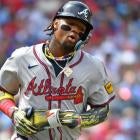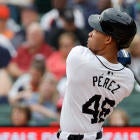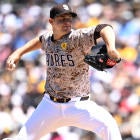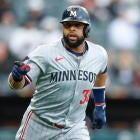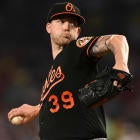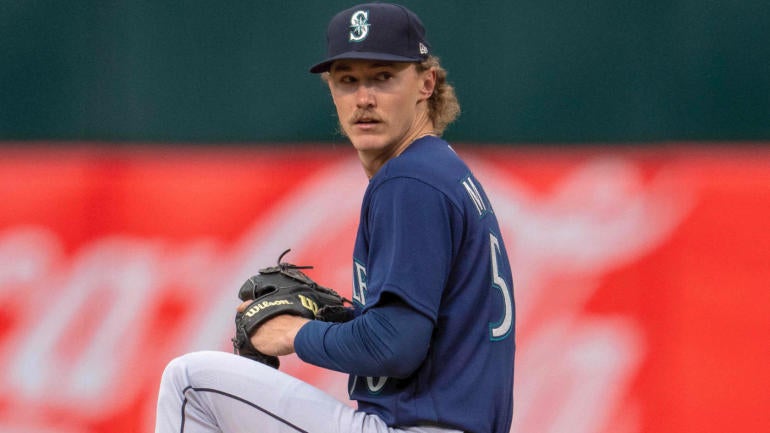
Pitching rankings change a whole lot more quickly than at other positions in the early part of the Fantasy Baseball season, and not just because of the absolutely ridiculous run of bad injury luck we've seen at the position to open the 2024 season.
No, it's also because we just get a lot more actionable information about pitchers in small sample sizes than we do with hitters. While you tend to need a hundred or more plate appearances to really even begin to know if a skill change might be for real for a hitter – usually more like several hundred – you can get a sense of whether a pitcher has made real, tangible changes fairly quickly. If a guy who has never thrown a specific type of pitch suddenly unveils one in his first inning of work, you know he's made a change; ditto if a guy suddenly starts throwing 2 mph harder than we've ever seen.
Of course, you still need a fairly robust sample size to know if those changes count as improvements. Is that new pitch actually an effective one? Can the pitcher maintain his control (and health!) with his new velocity? Those questions can't be answered after just one or two starts.
But we can start to project, and that's what we're doing today. I recently moved three starters way up in my rankings based on their first two starts of the season, with Jared Jones, Bryce Miller, and Mackenzie Gore all leaping into the top-50 in my Roto SP rankings. Here's why:
Jones has made exactly two starts in the majors, coming off a season where he had a 4.72 ERA at Triple-A, and yet I'm moving him into my top-40 at starting pitcher already. That's how impressive the 22-year-old right-hander has been in the early going.
It's easy to see the case for Jones, who averages 97.1 mph with his four-seam fastball and has what looks like an absolutely dominant slider. Now, it's worth noting that, for the most part, that's all he has – he has thrown his curveball just 14 times through two starts, with his changeup showing up just eight times. But we're in an era where guys like Spencer Strider, Justin Steele, and Kevin Gausman are competing for Cy Youngs while throwing their top two pitches 85% of the time or more, so that's no longer the impediment to success we once thought it was.
Now, to get away with it, you have to either manipulate the shape of your pitches expertly, as Steele does, or just have two overwhelming pitches, like Strider and Gausman. And, in Jones' case, both might be true. He throws from a low arm slot, which helps his high-90s fastball play up even more than it otherwise would, with FanGraphs' Stuff+ model giving Jones the highest-graded fastball in the majors right now. That's a heck of a starting point, but the slider might be even more interesting.
Jones averages 88 mph with his slider, but he kind of has two different versions of the pitch. In his start over the weekend against the Orioles, he threw 17 sliders between 85.6 mph and 88.1, and then 11 between 88.7 mph and 91.5 mph, and while both are sliders, they seem to operate differently; the slower version averages 35.4 inches of vertical break and 4.6 inches of horizontal break, while the harder version averages 31.7 and 3.5, respectively. Which is to say, the slower version is more like a traditional, two-plane slider, while the harder version might be more like a cutter.
The slider doesn't rate out quite as well as the fastball, but it still comes in with a 126 Stuff+, a top-20 mark in baseball in the small sample of this season so far. The arsenal looks a lot like Hunter Greene's in some ways, and that might be a reasonable comp for him at this point – Greene walked 9.1% of opposing hitters in his biggest sample size at Triple-A, while Jones walked 9.7%. Obviously, we're hoping for better results from Jones than we've gotten from Greene so far in his MLB career, but for what it's worth, I'm also expecting better results from Greene than we've gotten so far, which is why he's a top-36 starting pitcher for me this season.
That's the same range of the rankings I've moved Jones to after just two starts. He's SP38 for me in my latest rankings update, which will make him a top-150 player. Attrition is playing a part in that, of course – he wouldn't be in the top 40 if Spencer Strider, Shane BIeber, Eury Perez, and other injured pitchers were healthy.
But I also think it's just where Jones belongs right now. Can he keep this up? I think he has the stuff to do it, but there will probably be times when his command waivers, he surrenders some homers, and is as frustrating as Greene has been. He's a young pitcher with command issues historically, and I don't think he's already solved all of them for good.
If he has, I'm ranking him about 30 spots too low, because he might just be the next Strider. And, in a world where we can't seemingly rely on any pitcher to stay healthy, why shouldn't we be aggressive with how we rank brilliant young pitchers? Jones sure looks like he belongs.
Miller doesn't light the radar gun up quite the same way Jones does, but any discussion of him has always started with his fastball, a mid-90s pitch with ideal shape and movement that helped fuel his early-career success last season. Of course, he couldn't sustain that success even with one of the best fastballs in baseball – he's ninth in Stuff+ with his four-seamer right now – because, while his breaking balls (slider and sweeper) rated out well by the various stuff metrics, he lowered his arm slot when he delivered both, rendering them much less effective than they otherwise would be.
Miller needed another pitch, and I think he might have found it with his new splitter. It doesn't rate out too well by Stuff+, but those models have always had trouble grading splitters and changeups, because movement profiles and velocity don't necessarily tell you everything you need to know about how they'll play to hitters; success with those pitches relies as much on deception and duplicity as it does raw stuff, and that's much harder to quantify.
What we can quantify is how the pitch is working so far, and by that measure, this new pitch has been a resounding success. He has ended 16 plate appearances with his splitter so far, and eight of them have been by strikeout; he has a 52.2% whiff rate with the pitch in a small sample, which is simply a massive number. On the other eight plate appearances that have ended with a ball in play, he has given up just two singles, with a .189 expected wOBA allowed. It's early, but that splitter already looks much more effective than any other pitch for Miller.
One thing worth noting is he has faced a ton of lefties so far, with 31 of 47 plate appearances against Miller coming from the left side of the plate. He struggled against them last season, allowing a .917 OPS against, so it makes sense that the first two teams to face Miller stacked the lineup with lefties, but with this new splitter, he might be better situated to neutralize that platoon issue. In fact, righties might be the bigger issue for Miller if his breaking balls continue to underperform, though the four-seamer can still be a swing-and-miss pitch, and his newly prioritized sinker could be a way to steal a few easy outs against righties every start, too.

Fantasy Baseball Today Newsletter
Your Cheat Code To Fantasy Baseball
You're destined to gain an edge over your friends with advice from the award-winning FBT crew.
Thanks for signing up!
Keep an eye on your inbox.
Sorry!
There was an error processing your subscription.
Miller is still not a finished product, and the lack of a killer breaking ball might always hold him back from reaching his ceiling. But, at least in the early going, it looks like he's solved his biggest issue as a rookie, and that's worth getting excited about. I don't think the stuff is quite as impressive as it is with Jones, so I'm not sure he has the same kind of top-10 potential, but he might be a safer projection than Jones.
If I had to pick one player who deserves more hype than he's gotten in the early going, Gore would be my pick. He hasn't had a huge, double-digit strikeout effort, nor has he gone out and blanked a good lineup over seven innings, so his improvements may not jump off the page. But, as I wrote after his first start here, Gore seems to have made some refinements to his arsenal that are worth getting excited about.
As with Miller and Jones, we start with the fastball, which has the second-highest Stuff+ mark in baseball, after Jones. He's always had a good fastball, but with a jump in velocity early on from 95 to 97.1 mph, it might be a truly great pitch now. But what's really exciting about Gore is the changes he's made to his changeup. He has already thrown it 30 times through two starts, after he threw it just 72 times all season in 2023, and he's registered four batted balls with an average exit velocity of just 78.6 mph with it. That's a good start.
But it's the physical characteristics I'm most intrigued by. Gore has cut nearly 2 mph from his average changeup, increasing the velocity gap between that pitch and his changeup from 8.5 mph in 2023 to 12.5 so far. He's also cut the spin rate on the pitch from 2,175 rpm to 1,878, and a lower spin rate tends to be a good thing for changeups, leading to that classic late fade you're looking for from the best changeups.
Is this suddenly a Johan Santana-esque outpitch for Gore? It's probably unlikely to be so, but he's consistently getting whiffs in and around the strike zone with it, something we've never really consistently seen from Gore before:
Mackenzie Gore's changeup looks pretty good getting whiffs in the zone/shadow pic.twitter.com/av8GXyp6FG
— Chris Towers is the Riley Greene Preservation Soc (@CTowersCBS) April 8, 2024
So, we've got an improved fastball and improved changeup, with a pitcher who already posted a 37% whiff rate with both his curveball and slider last season. That seems like a pretty good thing, because Gore legitimately could have four above-average swing-and-miss pitches now – he's also throwing his slider harder, with more cutter-y movement, though it's still gotten good swing-and-miss results in the early going, which is a good sign. And, remember, Gore might have been even more hyped than either Jones or Miller at his peak as a prospect.
Pitching development is rarely linear, and Gore has long been an example of that – he was all over the place as a prospect, as he lost and then rediscovered his mechanics in the minors. But it looks like after a largely frustrating start to his MLB career, Gore has found both improved velocity and a more well-rounded arsenal. It hasn't led to huge production yet, but I think the upside is there to justify a top-50 ranking already.






















